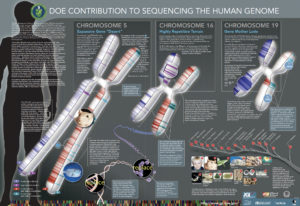2022 marks the JGI’s 25th anniversary. Over the next few months, we’ll be revisiting a number of notable achievements that showcase our collaborations and capabilities to enable great science that will help solve energy and environmental challenges.
The Human Genome Project began in 1990 when the U.S. Department of Energy (DOE) partnered with the National Institutes of Health. The DOE works with the National Nuclear Security Administration to maintain the U.S. nuclear weapons stockpile and was interested in investigating the effects of radiation exposure to human health. Three DOE national labs had people and resources focused on three human chromosomes:
- Lawrence Berkeley National Laboratory researchers were studying Chromosome 5, which contains about 6% of the human genome. They discovered genes linked to conditions such as cardiovascular disease, colorectal cancer.
- Lawrence Livermore National Laboratory had teams studying Chromosome 19, which contains about 2% of the human genome. They were interested in genes involved in repair of DNA damage, and those associated with atherosclerosis and diabetes mellitus.
- Los Alamos National Lab researchers investigated Chromosome 16, which contains about 3% of the human genome. They wanted to learn about the genes implicated in the development of breast and prostate cancer, and Crohn’s disease, among other conditions.
While scientists around the world were busy sequencing the human genome, an arms race was being waged. In this JGI@25 video, Susan Lucas, former JGI Production Department Head and current ESnet Deputy Director of Operations, shares her story of what it was like on the frontlines at the Joint Genome Institute. Hear her memories of what it was like sequencing around the clock and see some of the physical memorabilia that she’s held onto over the years.
The DOE brought together the people and resources from these three national labs to form the DOE Joint Genome Institute in 1997. Over the next seven years, and in collaboration with researchers at the Stanford Human Genome Center, JGI staff worked around the clock to generate the sequences of these three chromosomes. In 2004, they published the sequences of these three chromosomes. These sequences account for approximately 12% of the total human genome, which itself was finally deemed complete on April 1, 2022.
After completing the human genome, the JGI became a national user facility. The staff and resources shifted to offering genomic science capabilities for energy and environmental research. The collaboration with the Stanford Human Genome Center evolved and continues today as a partnership with the HudsonAlpha Institute for Biotechnology.
Publications:
- Grimwood, J., Gordon, L., Olsen, A. et al. The DNA sequence and biology of human chromosome 19. Nature. 428, 529–535 (2004). doi:10.1038/nature02399
- Schmutz, J., Martin, J., Terry, A. et al. The DNA sequence and comparative analysis of human chromosome 5. Nature. 431, 268–274 (2004). doi:10.1038/nature02919
- Martin, J., Han, C., Gordon, L. et al. The sequence and analysis of duplication-rich human chromosome 16. Nature. 432, 988–994 (2004). doi:10.1038/nature03187
Relevant Links:
- JGI Release: Researchers Decode Three Human Chromosomes
- JGI Release: International Human Genome Sequencing Consortium Announces “Working Draft” of Human Genome
- JGI Release: Gene-Rich Human Chromosome 19 Sequence Completed
- JGI Release: Human Chromosome 5 Final Sequence Analysis Released to Public
- JGI Release: Chromosome 16 Publication Fulfills DOE’s Human Genome Commitment
- JGI Feature: Jane Grimwood Named HudsonAlpha Genomics Chair
- Human Genome Project Information Archive: 1990-2003
